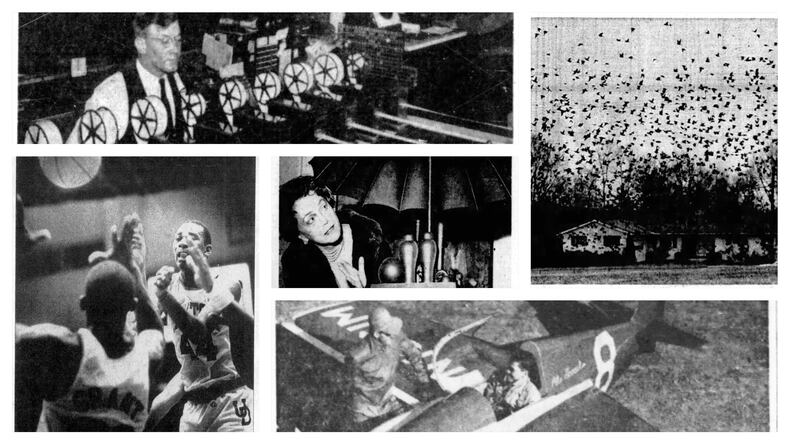Here’s a look at some stories from the week of Feb. 18-24.
Feb. 21, 1943: Permanent voice records made on calls summoning firemen to Dayton fires
Records of telephone calls to the Dayton Fire Department reporting fires and the dispatching of firefighters was made “foolproof” with the installation of a voice recording device in 1943.
The chief reason for the voice recorder or “sound scriber” as it was called, was to prevent any chance of unjust criticism of the department for any delay in fire truck dispatches and arrival times at the scene of a blaze.
The sound scriber worked on the same principal as a phonograph record, except that a cylindrical record was used, similar to the dictaphones of the time.
When a call was received, the phone operator would turn a switch and a recording of the complete conversation between the citizen and the operator would be captured. The exact time of the call would also be recorded and put into a permanent record.
The system only worked for phone calls. If a fire alarm was sounded from one of the fire boxes placed at strategic points in the city, an entirely different system was used to record the information.
Feb. 22, 1953: Daytonian buys tiny racer
In 1953, Paul Morris purchased a Pitts Special racing plane and planned to enter it in air races that season. He named the plane “Miss Dayton.”
The plane had a wing span of 15 feet, eight inches and weighed 560 pounds. It was powered by a four-cylinder, 85-horsepower, Continental engine. It had a normal cruising speed of 200 mph. Top speed was about 275 miles an hour.
The final race of the season was to be the Goodyear Trophy Race of the National Races that were to be held in Dayton.
However, Morris was pleasure pilot. For races, he hired Jim Greene of Miamisburg to handle the controls the pint-sized plane.
The plane was built by Curtis Pitts of Gainesville, Florida and finished third in the National Air Races in Detroit the previous year.
Feb. 23, 1964: A walk to the Art Institute entertainment for a Countess
Judith Hare, Countess of Listowel, was taking a break from her six-week tour schedule of 24 lectures and eight television interviews and decided to do so in Dayton.
Lady Listowel, of Chelsea, England, was born in 1907 in Hungary, lived in Rome, attended the London College of Economics and became a political commentator in Europe by age 19. She was married to William Hare, 5th Earl of Listowel.
Her latest project was the history of Tanganyika (now known as the United Republic of Tanzania).
While in town she decided to take a long walk in the snow to the Art Institute. While in a gallery, she said, “I know it’s my fault, but some of these paintings don’t tell me anything.”
Then suddenly she she came across a piece of art named “Memorial,” by Kortlander and clapped her hands. It was a moody piece of impressionist work.
Her biggest thrill of the day was seeing an oil painting called “The Blacksmith” in one of the permanent galleries.
“This is a thrill,” she said, “Von Munkacsy is Hungary’s foremost painter. I never thought I would find one here.”
Feb. 23, 1975: City hopes Starlings get message from big blasts
Thousands of starlings had decided to make their winter nesting grounds at the Madden golf course on Nicholas Road.
The birds were breaking tree branches, and their droppings posed a heath hazard.
The Dayton Human Resources department came up with a plan to move the birds out of the way. Specials shells were to explode at tree-height levels. Once the birds were airborne, another shell would explode to urge the birds to leave the area.
This was to continue for three to four nights in hopes the birds would come to an understanding that they were no longer welcome at the golf course.
The Ohio Wildlife division was to be in charge of the explosions. The plan had been used four or five years earlier with success.
Feb. 24, 1985: Anthony Grant(s) Flyers’ revenge
The University of Dayton’s head basketball coach, Anthony Grant, was a UD player in 1985 and a star of the night when the Flyers played Marquette.
Grant finished the game with 18 points and 14 rebounds in Dayton’s 72-59 victory before 13,455 fans at UD Arena.
Grant, a 6-foot-5 sophomore, had moved into the starting lineup after Ed Young suffered a knee injury. Grant had been in a slump, only scoring in double figures once in the previous seven games.
“I’m back,” said Grant, as the Flyers put an end to a three-game losing streak.
Marquette coach Rick Majerus said of Grant and the Flyers, “baseline drives, that’s what hurt us. Grant. We rotated and didn’t get off guard down low enough. He played a very good game.”
“It feels good,” Grant said, “I played with the fire I usually play with. I wasn’t playing as hard as I had been ... Every game from now on is a must-win.”
About the Author






